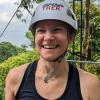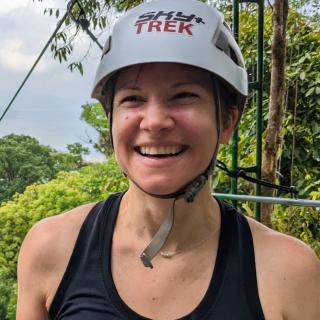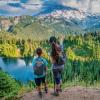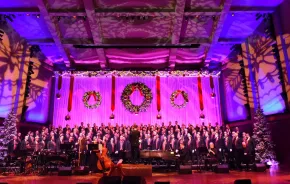
Photo:
iStock
Did you know that within a few hours’ drive of Seattle, you can find year-round icicles, sip cocoa on the floor of a 7,000-year-old shelter, or venture into an underground lava tube more than a mile deep? Washington state is home to truly unique, family-friendly caves, perfect for an adventurous and educational day out.
I've detailed four caves in Washington state you can visit with kids, plus given tips on how to make the most of these unforgettable experiences with your family this summer. If you want more adventure, I've got ideas for you: four more popular caves families flock to in Washington. And just to be on the safe side, etiquette and safety tips for families are included here too, so you can explore, stay safe and preserve these truly unusual destinations for future generations.
So grab your headlamp and extra layer, it's time to explore!
Ape Cave, Cougar
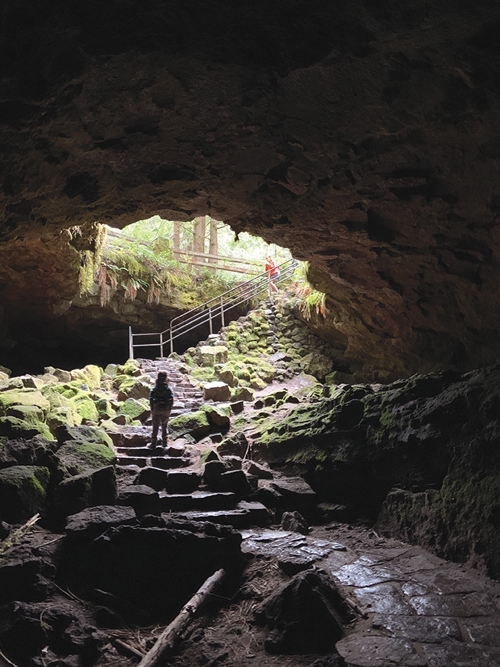
Washington state is home to the third-longest accessible lava tube in North America. Located on the south side of Mount St. Helens, an ancient lava tube known as Ape Cave stretches over 2.5 miles and offers a choose-your-own-adventure experience for the whole family. Explore the more open, shorter lower cave with everyone, or if you are feeling more daring, venture into the narrower, more technically challenging upper cave.
You will descend a single staircase for both portions of the cave. The lower cave offers an easy, gently sloping .75-mile round-trip walk, which will take less than an hour to complete. If you choose to go for the upper cave, you will navigate 1.5 miles underground before emerging via a ladder at the upper entrance. This rugged trek will require some physical agility and stamina, and may take several hours. You’ll scramble over large boulders and scale a slippery 8-foot-high wall. The 1.3-mile overground return is an easy walk and rather otherworldly as you wander through forest and the remains of past lava flows. Food isn’t permitted in the cave, so plan accordingly.
Book your reservations in advance to be sure you get the opportunity to check out this geologic marvel. No pets, smoking, alcohol, fireworks, fires, camping, touching the wall “slime,” or rock collecting is permitted at Ape Cave.
Getting there: Follow the driving directions to the Ape Cave. There is a large parking lot once you pass through the ranger checkpoint. The paved walkway to the cave entrance is well-marked.
Parking: Cost is $5 per day per vehicle or free with a valid Recreation Pass.
Amenities: There are vault toilets near the parking lot. No water is available. Ranger-led programs may be offered occasionally.
Accessibility: The parking lot and walkways to the cave entrance are paved. Stairs lead down to both the lower and upper caves.
How and when to visit: Timed reservations are available online during the open season, May 28–Oct. 31. Tickets are free, though there is a $2 administrative fee. Tickets cannot be purchased at the site of the cave, and cellular service in the area is limited.
Nearby attractions: Don’t miss the Trail of Two Forests on your way to or from the cave. This easy, half-mile boardwalk trail sits between old- and new-growth forests separated by 2,000 years. The kids will love climbing down short ladders into lava-cast tree molds.
Gardner Cave, Metaline Falls
Believed to be more than 5 million years old and one of the only limestone caves in the state, Gardner Cave should be on the itinerary of any cave-loving visitor to northeastern Washington. To visit Gardner Cave, you will need a reservation for one of the free daily tours. (Secure a tour well in advance; they book up fast!) Unlike other caves in Washington, Gardner Cave is illuminated using electric lights. An interpretive guide will take you through the first 494 feet of the 2,072-foot-long cave, along the way teaching you about the impressive cave formations, including stalagmites, stalactites, flowstones, rimstone pools and a 7.8-ton column — the largest in the Pacific Northwest.
Getting there: Drive to Crawford State Park Heritage Site, where there is a large parking lot. Follow the signs to meet your tour.
Parking: A Discover Pass is required to park in Crawford State Park.
Amenities: Restrooms, drinking water, covered shelters, picnic tables
Accessibility: Paved walkways lead to the cave entrance and continue within. Climbing stairs is necessary to enter the cave.
How and when to visit: Visitors are welcome May 16–Sept. 15 for reserved tours only. Tours are free (though donations are accepted) and can be booked online. or calling (509) 238-4258. Tours are offered Thursday–Monday, every two hours beginning at 10 a.m. A condensed, family-friendly tour is offered at noon and is recommended for children 5 and younger.
Nearby attractions: Don’t miss the .25-mile trail leading from the park to the Canadian border. And there’s lots of family-friendly fun to be found in Spokane on your way.
Guler Ice Cave, Trout Lake

Located a few miles south of Mount Adams, Guler Ice Cave, an old volcanic lava tube, is intriguing for its year-round ice formations. The cave is accessible all year around; walk a short, easy trail during warmer months, or snowshoe for 1 mile to reach the cave during winter. There are several ways to enter or exit the cave, as well as tunnels to explore. From the main entrance, you’ll descend 20 feet down a staircase. The cave’s floor is icy throughout the year, and you may want to wear microspikes over your footwear. Don’t forget to shine your lights on the cave walls — if you are lucky, you may see the “crystal grotto,” a phenomenon that happens when bacteria and fungi trap water and reflect light to give it a sparkly effect.
Getting there: From April to October, you can drive directly to Guler Ice Cave. Park in the small lot and take a short walk (less than .5 mile) to the cave entrance. From November to March, drive to the Atkisson Sno-Park. Once there, don your snowshoes or cross-country skis and follow the signs; it’s a short trek of about 1 mile.
Parking: A valid Recreation Pass or a fee of $5 per day per vehicle is required. From Nov. 1 to March 31, a Sno-Park permit is required at Atkisson Sno-Park.
Amenities: There is a vault toilet and picnic shelter at the parking lot. No drinking water is available.
Accessibility: Entering the cave requires climbing stairs.
How and when to visit: Although the cave is accessible year-round, some say the ice is most impressive in late spring when snow melting into the cave creates the most fully formed ice shapes.
Nearby attractions: One and a half miles past the ice cave parking lot , you’ll find the easy .8-mile Natural Bridges Trail, which can be recognized by its own small parking lot. In addition, the Columbia River Gorge is less than an hour’s drive from the caves, and it’s spectacular!
Layser Cave, Randle
Layser Cave, an unassuming archaeological wonder, is tucked between the Gifford Pinchot National Forest and Mount Rainier National Park. Located outside Randle, the cave is just a three-hour drive from downtown Seattle. With a short .25-mile walk to the cave entrance, this is a perfect cave to visit with young kids.
While small in size, measuring 40 by 60 feet, Layser Cave is considered to be one of the most archaeologically significant caves in western Washington. Experts believe this area may have been inhabited by humans as many as 7,000 years ago. The interpretive trail includes signage explaining how archeologists pieced together the history of the area after uncovering numerous items, including tools, cooking utensils, art, religious items and shelter material. Pack a mug of cocoa and sit on a cave floor with your kids to imagine what it might have been like to take shelter in this cave thousands of years ago.
Fun fact: Layser Cave is a pseudokarst cave, meaning that it appears to have been created by the dissolution of bedrock, like a karst cave. It’s more likely, however, that it was formed by tectonic activity.
Getting there: Once you’ve arrived at the parking area for the Layser Cave trailhead, note that the hard-to-see trailhead is on a hairpin turn that goes up, to the left.
Parking: A Northwest Forest Pass is required.
Accessibility: The trail is unpaved and has a series of steps, making this trail inaccessible to wheelchairs and strollers.
Amenities: No restrooms or drinking water are available at the trailhead.
How and when to visit: While it is technically accessible year-round, the road may close due to weather. Spring, summer and early fall are the best times to visit.
Nearby attractions: Travel a few miles farther south on NF-23 for another easy .25-mile hike to Camp Creek Falls. Layser and Camp CreekFalls make great stops en route to the Gifford Pinchot National Forest or on your way to Mount Rainier National Park via Packwood.
More caves in Washington to explore with kids
For more summer spelunking adventures, check out these other options around the state.
- Boulder Cave in Naches. A 1.5-mile round-trip trail meanders through a 330-foot basalt rock cave, which was created by erosion. The cave is open from mid-May to late September; reservations are required and can be made online.
- Big Four Ice Caves in Granite. Just two hours from Seattle, this easy 2.2-mile round-trip hike offers a view of four glacier caves. Do not enter these caves. Glacier caves can be very unstable, and people have been killed by venturing into them.
- Tamanowas Rock Sanctuary in Chimacum. This sacred site on the Olympic Peninsula is protected through the Jefferson Land Trust, but is open to the public. The formation features small caves scattered throughout a giant rock face.
- Cheese Cave in Trout Lake. Not far from the Guler Ice Caves, you can see remnants of shelves once used by the Guler Cheese Co. to store cheese and potatoes in this lava tube turned refrigerator.
Etiquette and safety tips for families
Before you plan your spelunking adventure, keep these safety precautions in mind for visiting caves with kids in tow:
- Choose a family-friendly cave. The caves were selected because they are generally safe options to visit with children. Washington state has an extensive network of other caves that may require specialized training and gear.
- Wear proper clothing. Wear sturdy, closed-toe shoes and bring layers. Caves typically maintain temperatures of 39–42 degrees Fahrenheit all year around.
- Bring a light source. Don’t rely on your cell phone to light your way. Bring a flashlight, headlamp or lantern, preferably one per person. For longer caves, such as Ape Cave, consider bringing backup batteries.
- Leave pets at home. Pets — even leashed — are not allowed in caves.
- Avoid touching cave features. Look, don’t touch! Oils and dirt from your hands can damage cave features, such as stalactites and stalagmites, and kill “cave slime,” which is a vital food source for many cave-dwelling creatures.
- Read and follow signage. Different caves may have different rules to protect them and their specific inhabitants. Always read and follow the signage.
- Leave no trace. Be a steward of these beautiful caves and if you can, leave them better than you found them.
Do you have a budding speleologist at home? Explore resources offered by the National Cave and Karst Research Institute or connect with local experts through Cascade Grotto, Washington’s chapter of the National Speleological Society.



